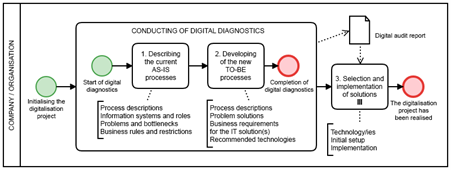How to implement digitalisation?
Author: Lauri Antalainen
What is digitalisation?
My definition of Digitalisation: it is the development of processes through the application of information technology. It is hereby important to draw attention to the words “the development of processes” – the application of technology or the utilisation of software is never a final solution on its own, but a means of making processes more efficient. It is therefore not correct to observe digitialsation as the application of a software program, but as an important change in the internal processes of an organisation that is realised (amongst others), with the assistance of software.
Digitalisation starts with a digital audit
A properly thought-out and prepared digitalisation project begins with the realisation of a digital audit. Digital diagnostics (also known as a digital audit) is a systematic analysis of the possibilities of developing the processes of a company through the application of digitalisation and automation solutions.
The first step in realising digital diagnostics is the AS-IS mapping (mapping of the existing processes). These processes, as well as their related problems and bottlenecks, are described in detail during the mapping stage. The mapping stage must be detailed, describing the roles of the employees involved in each business process, the solutions they use, how the processing information flows and the businesses’ rules. This information will assist in being able to understand possible restrictions to making changes to processes and to foresee possibilities for establishing process standards.

The next step after the AS-IS process is the development of the new (TO-BE) processes. This stage aims to eliminate the major problems and bottlenecks of the AS-IS processes. The differences in comparison to the AS-IS processes are highlighted and the solutions to the problems and bottlenecks described. The business requirements of the technological solutions (e.g. software) to be implemented and recommended software are highlighted.
This step completes the realisation of the digital diagnostics and a digital diagnostics report is completed. Then, the introduction of the process changes can be initiated.
Selecting and deploying solutions
If the digital diagnostics has been executed correctly, the descriptions of the changes to the processes and the business requirements of the solution(s) to be used will be available, as well as recommendations for the consideration of one or more software programs. The descriptions of the business requirements and changes to the process are hereby of critical importance as they allow the company delivering the concrete solution, which cannot be the conductor of the digital audit due to a conflict of interest, to configure the software and implement it for the company in the most optimal way. The recommendations of the software are also not of minor importance – the conductor of the digital diagnostics has the best understanding of the most optimal solutions for the company. There is also, in many cases, no need or reason to apply especially expensive and powerful IT solutions, whereby a fraction of the functionality of the software will be used by the company. Just like it makes no sense to go pick up the dining table purchased from the furniture shop with a big Scania truck.
The solution, once selected, must be implemented. The more trivial part of phasing in software is its installation and even executing its interfacing; experience indicates that significantly more problems occur, as a rule, with phasing in process changes. As the digitalisation project brings with it changes in processes, it will also always mean changing the employees’ existing patterns of activity and habits. The phasing in of a software (e.g. an ERP system), in some cases, is assisted by the supplier of the solution; the phasing in, in other cases, can be executed internally.
It is possible to complete many digitalisation projects based on the execution of a single digital audit. One component of the digital audit/digital diagnostics is the Digitalisation Roadmap which highlights recommendations for the realisation of digitalisation projects for the upcoming years. Digiwise can assist you in conducting digital diagnostics, the preparation of digitalisation projects, as well as the successful completion of failed digitalisation projects. If interested, contact us on info/at/digiwise.ee